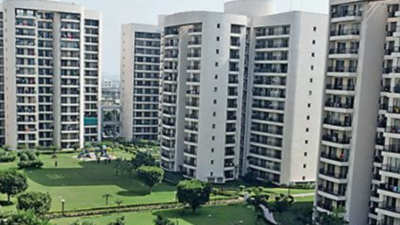- News
- City News
- gurgaon News
- Gurugram: Vacate 2 more Chintels Paradiso towers immediately, says govt panel
Gurugram: Vacate 2 more Chintels Paradiso towers immediately, says govt panel

Repairs were on at D-603, whose floor gave way, sending a cascade of concrete tumbling in a line all the way to the first floor
GURUGRAM: The government committee investigating the vertical collapse of five living rooms this February at an 18-storey residential tower in Chintels Paradiso has identified rapid and early corrosion of the building's steel reinforcements due to the presence of excessive chloride in concrete as the root cause and faulty renovation methodology coupled with lack of supervision of an apartment where repairs were on as the immediate cause of the cave-in.

The committee has, meanwhile, recommended that towers E and F of the condominium should be vacated immediately for safety of residents after complaints of "sagging" balconies and other construction problems. Some families have already left their apartments in these towers since the cave-in.
The February 10 tragedy claimed the lives of two residents in their second and first-floor apartments, Ekta Bhardwaj (31) and Sunita Srivastava (55).
Repairs were on at D-603, whose floor gave way, sending a cascade of concrete tumbling in a line all the way to the first floor.
The four-member committee, headed by additional deputy commissioner Vishram Kumar Meena, was set up to probe why the flats collapsed. Its other members were district town planner (enforcement) Amit Madholia, ACP Udyog Vihar Rajiv Yadav and PWD superintending engineer Pravin Chaudhary. The committee submitted its report on November 8.
"On the basis of statements of the estate manager of developer company (Chintels) and construction company (Manish Switchgear), it is clear that wrong methodology adopted in the repair work of flat number D-603 led to immediate collapse. The collapse of the floors indicates there are structural deficiencies in the overall structure of Tower D and it is due to corrosion of the reinforcement that occurred due to presence of excessive chlorides in the concrete," the report said.
Manish Switchgear was carrying out repairs at D-603.
The report added that retrofitting work at D-603 needed shuttering support, but that wasn't done. The representatives of the company failed to regulate and monitor the retrofitting work, which led to the collapse of the slab (floor) and ensuing damage to the lower floors, the report said.
The committee also cited findings of IIT-Delhi's structural audit of Tower D. "As per the IIT-Delhi report, the structure of Tower D is not safe for habitation and due to high chloride content in the concrete throughout the structure, the structure is also not technically and economically feasible for any kind of repair. The committee is of the view that Tower D should be permanently closed and the developer should start the process of demolition of this tower," the report said.
Observing that issues raised by residents and RWAs were neglected by the developer, the committee underlined concerns about construction quality that residents of other towers have been voicing, both before and after the February 10 incident. Citing the IIT findings on corrosion of reinforcements in the building, the report said, "It has been mentioned that same signs of corrosion of reinforcement are visible in all towers of the project. The root cause of the collapse is attributed to the inherent problem of excessive chloride content in RCC (reinforced cement concrete) which induces and accelerates corrosion in the reinforcement. This led to the deterioration of the concrete and further necessitated repair work, which was being carried out in flat D-603."
"The value offered by the developer to flat owners should not be less than the evaluation done," said deputy commissioner Nishant Yadav.

The committee has, meanwhile, recommended that towers E and F of the condominium should be vacated immediately for safety of residents after complaints of "sagging" balconies and other construction problems. Some families have already left their apartments in these towers since the cave-in.
The February 10 tragedy claimed the lives of two residents in their second and first-floor apartments, Ekta Bhardwaj (31) and Sunita Srivastava (55).
Repairs were on at D-603, whose floor gave way, sending a cascade of concrete tumbling in a line all the way to the first floor.
The four-member committee, headed by additional deputy commissioner Vishram Kumar Meena, was set up to probe why the flats collapsed. Its other members were district town planner (enforcement) Amit Madholia, ACP Udyog Vihar Rajiv Yadav and PWD superintending engineer Pravin Chaudhary. The committee submitted its report on November 8.
"On the basis of statements of the estate manager of developer company (Chintels) and construction company (Manish Switchgear), it is clear that wrong methodology adopted in the repair work of flat number D-603 led to immediate collapse. The collapse of the floors indicates there are structural deficiencies in the overall structure of Tower D and it is due to corrosion of the reinforcement that occurred due to presence of excessive chlorides in the concrete," the report said.
Manish Switchgear was carrying out repairs at D-603.
The report added that retrofitting work at D-603 needed shuttering support, but that wasn't done. The representatives of the company failed to regulate and monitor the retrofitting work, which led to the collapse of the slab (floor) and ensuing damage to the lower floors, the report said.
The committee also cited findings of IIT-Delhi's structural audit of Tower D. "As per the IIT-Delhi report, the structure of Tower D is not safe for habitation and due to high chloride content in the concrete throughout the structure, the structure is also not technically and economically feasible for any kind of repair. The committee is of the view that Tower D should be permanently closed and the developer should start the process of demolition of this tower," the report said.
Observing that issues raised by residents and RWAs were neglected by the developer, the committee underlined concerns about construction quality that residents of other towers have been voicing, both before and after the February 10 incident. Citing the IIT findings on corrosion of reinforcements in the building, the report said, "It has been mentioned that same signs of corrosion of reinforcement are visible in all towers of the project. The root cause of the collapse is attributed to the inherent problem of excessive chloride content in RCC (reinforced cement concrete) which induces and accelerates corrosion in the reinforcement. This led to the deterioration of the concrete and further necessitated repair work, which was being carried out in flat D-603."
"The value offered by the developer to flat owners should not be less than the evaluation done," said deputy commissioner Nishant Yadav.
FOLLOW US ON SOCIAL MEDIA
FacebookTwitterInstagramKOO APPYOUTUBE
Start a Conversation
end of article









